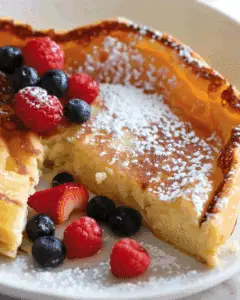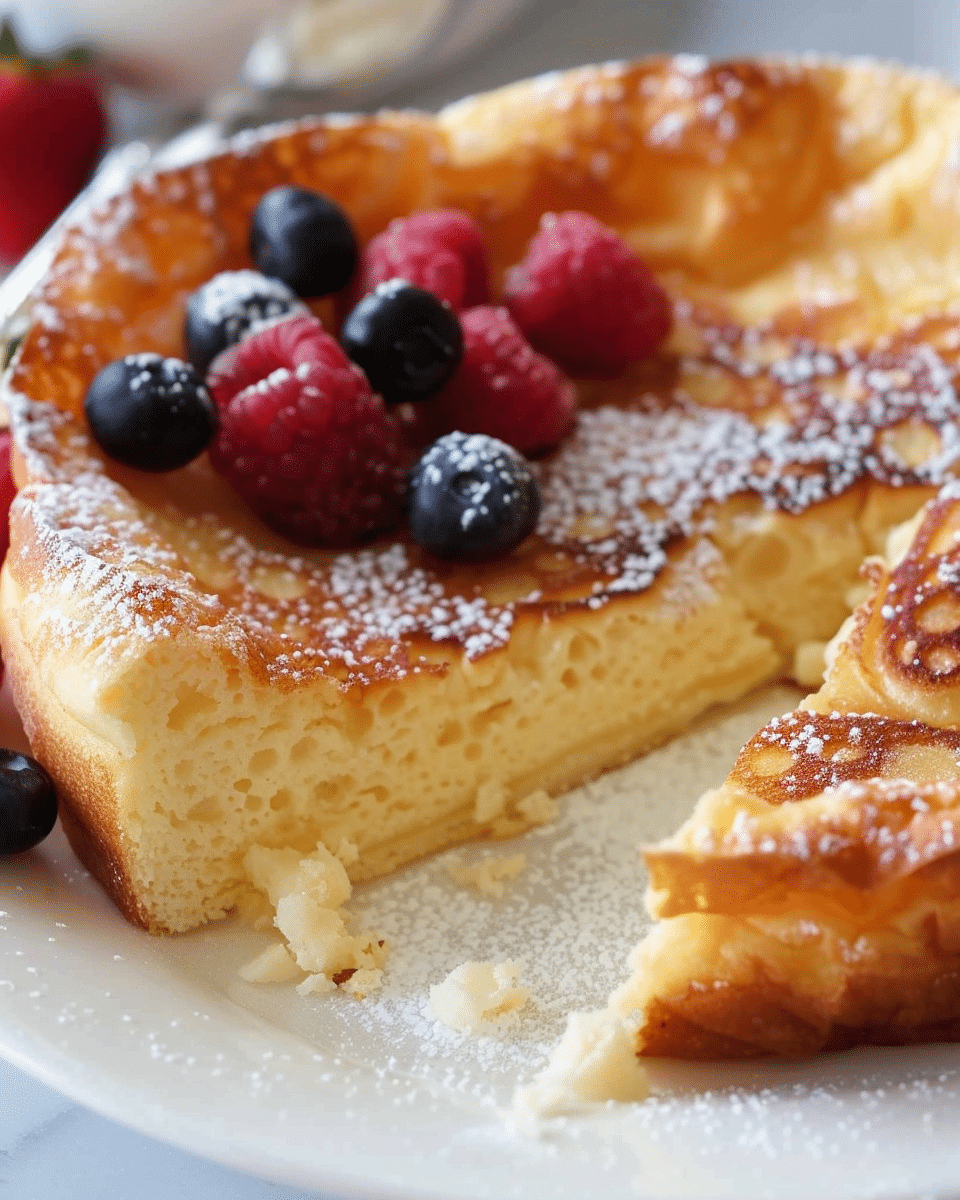German pancakes, also known as Dutch babies, are a delightful breakfast treat that puffs up beautifully in the oven, creating a light, airy pancake with crispy edges and a tender center. Unlike traditional pancakes, these require no flipping and bake entirely in the oven, making them perfect for a stress-free breakfast or brunch.
Why You’ll Love This Recipe
This German pancake recipe is a true crowd-pleaser for so many reasons. The dramatic puff that happens in the oven makes for an impressive presentation that will wow your family or guests. Beyond looks, these pancakes offer the perfect balance of textures—crispy golden edges with a tender, slightly custardy center. They’re incredibly versatile and can be topped with sweet or savory ingredients depending on your mood. Best of all, they come together in minutes with basic pantry staples, requiring minimal cleanup since everything mixes in one blender. Whether you’re preparing a special weekend breakfast or a quick weeknight dinner, German pancakes deliver maximum impact with minimal effort.
Ingredients
(Tip: You’ll find the full list of ingredients and measurements in the recipe card below.)
All-purpose flour serves as the foundation for this recipe, providing structure to the pancake while still allowing it to rise and puff beautifully in the oven.
Milk adds necessary moisture and helps create that tender, custard-like texture in the center of the pancake. Whole milk works best, but 2% will also yield good results.
Eggs are crucial in German pancakes—they provide the leavening power that creates that dramatic puff in the oven. The high egg content also gives these pancakes their signature rich, custard-like interior.
Unsalted butter enhances the flavor and helps create those irresistibly crispy edges. The melted butter incorporated into the batter adds richness, while buttering the pan prevents sticking and contributes to the golden-brown exterior.
Sugar adds just a touch of sweetness to the batter, balancing the flavors without making the pancake overly sweet. This allows the pancake to work well with both sweet and savory toppings.
Vanilla extract brings a subtle aromatic quality that enhances the overall flavor profile. Its warm notes complement the eggy richness of the pancake.
Powdered sugar is traditionally dusted over the finished pancake for both visual appeal and a light sweetness that doesn’t overwhelm the delicate flavor.
Maple syrup serves as the classic topping, adding sweetness and moisture to each slice, though German pancakes are versatile enough to pair with numerous other toppings.
Directions
- Preheat the oven to 425°F (220°C) and grease a large baking dish or cast iron skillet.
- In a blender, combine the flour, milk, eggs, melted butter, sugar, and vanilla extract. Blend until smooth.
- Pour the batter into the prepared dish and bake for 20-25 minutes, or until the pancake is puffed up and golden brown.
- Remove from the oven and dust with powdered sugar. Serve with maple syrup or your favorite toppings.
Servings and Timing
This recipe yields 4 generous servings, making it perfect for a family breakfast. The preparation takes just 5 minutes, with a cooking time of 25 minutes, for a total time of 30 minutes from start to finish. Each serving contains approximately 350 calories, offering a satisfying but not overly heavy breakfast option.
Variations
Fresh Fruit German Pancakes: Add sliced apples, peaches, or berries to the batter or sprinkle them on top before baking.
Savory Version: Omit the sugar and vanilla, and add herbs like thyme or rosemary to the batter. Top with sautéed mushrooms, cheese, or smoked salmon after baking.
Lemon and Blueberry: Add lemon zest to the batter and serve with fresh blueberries and a lemon-infused powdered sugar.
Cinnamon Sugar: Mix cinnamon into the batter and sprinkle a cinnamon-sugar mixture on top after baking.
Chocolate Lover’s: Add a tablespoon of cocoa powder to the batter and serve with chocolate chips and chocolate syrup.
Nutty Delight: Sprinkle toasted nuts like almonds or pecans over the top before serving for added crunch and flavor.
Storage/Reheating
German pancakes are best enjoyed immediately while hot and puffy out of the oven, as they do deflate somewhat as they cool. However, leftover pancakes can be stored in an airtight container in the refrigerator for up to 2 days.
To reheat, place individual portions in a preheated 350°F (175°C) oven for 5-7 minutes until warmed through. You can also use a microwave for 20-30 seconds, though this may result in a slightly softer texture without the crispy edges.
For make-ahead preparation, you can mix the batter the night before and store it covered in the refrigerator. Give it a quick stir or blend before pouring into your hot pan and baking as directed.

FAQs
Why didn’t my German pancake puff up as expected?
Your oven temperature is crucial for achieving that dramatic rise. Make sure your oven is fully preheated to 425°F before baking. Also, ensure your baking dish or skillet is properly heated before adding the batter, and avoid opening the oven door during the first 15 minutes of baking.
Can I make German pancakes without a blender?
Yes, you can mix the batter by hand with a whisk. Start by whisking the eggs until frothy, then gradually add the other ingredients, making sure to whisk out any lumps in the flour for a smooth batter.
What’s the best pan to use for German pancakes?
A cast-iron skillet is ideal because it retains heat well and helps create those crispy edges. However, any oven-safe dish will work, including glass baking dishes or metal cake pans. Just ensure it’s well-greased before adding the batter.
Can I use a different type of flour?
While all-purpose flour is traditional, you can experiment with whole wheat flour (use 3/4 cup whole wheat to 1/4 cup all-purpose for best results) or gluten-free flour blends designed for 1:1 substitution.
My pancake stuck to the pan. What went wrong?
The pan must be generously greased with butter before adding the batter. If using a cast-iron skillet, ensure it’s well-seasoned. For particularly stubborn pans, consider lining the bottom with parchment paper.
Can I make mini German pancakes?
Absolutely! Use a muffin tin instead of a single large pan. Grease each cup well, fill about halfway with batter, and reduce the baking time to 12-15 minutes.
Why is it called a German pancake when it’s not traditionally German?
Despite the name, German pancakes (or Dutch babies) are actually an American creation inspired by German Pfannkuchen. The “Dutch” in Dutch baby is actually a corruption of “Deutsch,” meaning German.
Can I make this recipe dairy-free?
Yes, substitute the milk with any plant-based milk (almond, oat, or soy work well) and use a plant-based butter alternative or coconut oil instead of butter.
How do I know when my German pancake is done?
A perfectly cooked German pancake will be dramatically puffed up, with golden-brown edges and a slightly golden top. The center should be set but might still have a slight jiggle to it.
Can I double this recipe?
Yes, but instead of making one large pancake, it’s better to bake two separate pancakes in two pans. A single oversized pancake may not cook evenly or achieve the same dramatic puff.
Conclusion
German pancakes offer a delightful departure from traditional pancakes, with their impressive rise and versatile nature. This simple recipe transforms basic ingredients into an extraordinary breakfast that feels special enough for celebrations yet easy enough for everyday mornings. The beauty of German pancakes lies in their adaptability—dress them up with fresh fruits and whipped cream for a sweet treat, or take them in a savory direction with herbs and cheese. Whatever toppings you choose, the pillowy texture and golden edges provide the perfect canvas. Give this recipe a try the next time you want to elevate your breakfast routine without spending hours in the kitchen. Your family or guests will be impressed not just by the dramatic presentation, but by the delicious flavors in every bite.
Print
German Pancakes
German Pancakes are a delicious and fluffy breakfast or brunch dish, prepared with simple ingredients and baked to golden perfection in the oven.
- Total Time: 30 minutes
- Yield: 4 servings
Ingredients
- 1 cup all-purpose flour
- 1 cup milk
- 6 large eggs
- 1/4 cup unsalted butter, melted
- 1 tablespoon sugar
- 1/2 teaspoon vanilla extract
- Powdered sugar, for dusting
- Maple syrup, for serving
Instructions
- Preheat the oven to 425°F (220°C) and grease a large baking dish or cast iron skillet.
- In a blender, combine the flour, milk, eggs, melted butter, sugar, and vanilla extract. Blend until smooth.
- Pour the batter into the prepared dish and bake for 20-25 minutes, or until the pancake is puffed up and golden brown.
- Remove from the oven and dust with powdered sugar. Serve with maple syrup or your favorite toppings.
Notes
- Ensure the oven is fully preheated before baking to achieve the perfect puff and golden color.
- Serve immediately to enjoy the fluffy texture, as the pancake will deflate slightly as it cools.
- Prep Time: 5 minutes
- Cook Time: 25 minutes
- Category: Breakfast
- Method: Baking
- Cuisine: German
- Diet: Vegetarian
Nutrition
- Serving Size: 1 serving
- Calories: 350 kcal
- Sugar: 5 g
- Sodium: 120 mg
- Fat: 14 g
- Saturated Fat: 7 g
- Unsaturated Fat: 6 g
- Trans Fat: 0 g
- Carbohydrates: 40 g
- Fiber: 1 g
- Protein: 11 g
- Cholesterol: 215 mg


